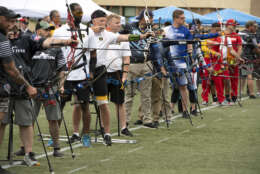Defense Department
-
DoD has gone some way toward easing the health care access problems employees in Japan have faced. But Congress is paying attention to ongoing challenges.
July 17, 2023 -
For nearly 18 months, the United States and its allies have shored up Ukraine with advanced weapons and ammunition. Early on, a policy office deep in the Pentagon coordinated efforts to enlist more than 50 countries to gather up not only weapons, but also medical supplies, ambulances and clothing. Laura Cooper is Deputy Assistant Secretary of Defense for Russia, Ukraine and Eurasia, or RUE. For her work in to help Ukraine, she's a finalist in this year's Service to America Medals program, orchestrated by the non-partisan Partnership for Public Service.
July 13, 2023 -
The annual Warrior Games bring together wounded, ill and injured service members and veterans in Olympic-style competition. They compete at what are called adaptive sports. Global Consulting Firm Booz Allen participated by bringing human performance and data analytics practitioners.
July 12, 2023 -
The Defense Department has been steadily developing artificial intelligence capabilities. But how should it go about purchasing AI tools? To get some ideas, the Government Accountability Office recently looked into how a handful of companies handle it.
July 12, 2023 -
In today's Federal Newscast: Virginia Sens. Warner and Kaine send a detailed letter to the Defense Department decrying the lack of reforms to privatized military housing. GSA is turning up its protections to better mitigate supply chain risks. And Customs and Border Protection lays out its agency-wide IT plans.
July 11, 2023 -
The Defense Department, as it steps up its readiness around artificial intelligence, is building up the data literacy of its acquisition workforce.
July 04, 2023 -
This week, the Department of Defense launched the Defense Civilian Training Corps, a scholarship for service program designed to modernize the civilian acquisition workforce in partnership with higher education.
June 09, 2023 -
While the federal contracting world was worrying about a giant but slow-moving contractor cybersecurity requirement from the Defense Department, Veterans Affairs went ahead with a doozy of its own.
June 08, 2023 -
Photochemical scientists from Bowling Green State University in Ohio, together with an R & D company, have developed — for the Defense Department — lenses that go from light-to-dark and dark-to light, in the blink of an eye.
May 23, 2023 -
Perhaps you have heard of CMMC, the Cybersecurity Maturity Model Certification program. Now in its 2.0 version, it is supposed to lay minimum cybersecurity standards on contractors doing business with the Defense Department.
May 10, 2023 -
The Pentagon’s CIO’s office wants to better quantify its IT user experience problems and find solutions.
May 09, 2023 -
Agencies are honing in on how best to secure software and gain better visibility into their suppliers. We talk to leaders from DoD, FDA, GSA, NASA and State to reveal how agencies are meeting demands for visibility into their vendors’ cyber practices.
March 29, 2023 -
Agencies have new guidance from the Office of Personnel Management to implement a federal rotational cyber workforce program, which will officially launch this November.
March 21, 2023 -
From cloud computing contracts to Defense business systems, the DoD CIO’s office wants to help components retire technical debt, improve integration and reduce duplication. We get a first-hand account of what’s planned from DoD’s Lily Zeleke.
March 21, 2023 -
The Defense Department is testing out an artificial intelligence tool to help the agency write contracts and speed up the federal acquisition process.
February 09, 2023















